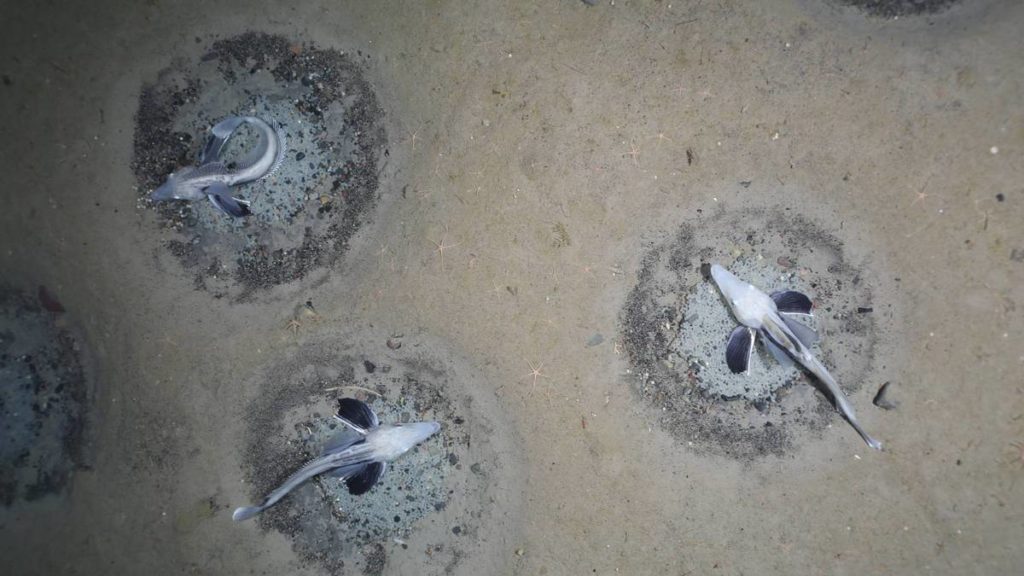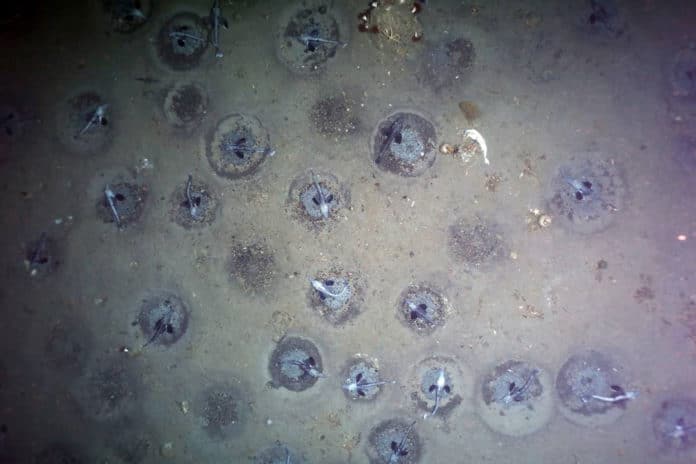Using a towed camera system, a team of scientists recently discovered the world’s largest fish breeding area near the Filchner Ice Shelf in the south of the Antarctic Weddell Sea. They photographed and filmed several nests of icefish of the species Neopagetopsis.
The unique observations are made with a so-called OFOBS, the Ocean Floor Observation and Bathymetry System, a camera system built to explore the seafloor of extreme environments, like ice-covered seas. Scientists towed the camera on a special fiber-optic and power cable generally at a speed of about one-half to one knot, about one and a half meters above the seafloor.
In February 2021, the team aboard the research vessel Polarstern found the mind-bogglingly massive icefish breeding colony while surveying the seabed with this camera system. The photos revealed numerous fish nests. Further observation shows that on average, one breeding site per three square meters, the team found a maximum of one to two active nests per square meter.
The team estimated the total number of fish nests around 60 million. The nests are round, 15 centimeters deep, and 75 centimeters diameter.
Autun Purser, a deep-sea biologist at the Alfred Wegener Institute, Helmholtz Centre for Polar and Marine Research (AWI), and lead author of the current publication, said, “The idea that such a huge breeding area of icefish in the Weddell Sea was previously undiscovered is fascinating.”

“After the spectacular discovery of the many fish nests, we thought about a strategy on board to find out how large the breeding area was – there was no end in sight. The nests are three-quarters of a meter in diameter – so they are much larger than the structures and creatures, some of which are only centimeters in size, that we normally detect with the OFOBS system.”
“So, we were able to increase the height above ground to about three meters and the towing speed to a maximum of three knots, thus multiplying the area investigated. We covered an area of 45,600 square meters and counted an incredible 16,160 fish nests on the photo and video footage.”
The team distinguished several types of fish nests: “Active” nests, containing between 1,500 and 2,500 eggs and guarded in three-quarters of the cases by an adult icefish of the species Neopagetopsis ionah, or nests which had only eggs; there were also unused nests, in the vicinity of which either only a fish without eggs could be seen, or a dead fish.
When the results were combined with oceanographic and biological data, the outcomes revealed that the breeding area corresponds spatially with the inflow of warmer deep water from the Weddell Sea onto the higher shelf. Further analysis revealed that the region is a popular destination for Weddell seals. Scientists also calculate the biomass of the ice fish colony there at 60 thousand tonnes.
German Federal Research Minister Bettina Stark-Watzinger said: “My congratulations to the researchers involved on their fascinating discovery. After the MOSAiC expedition, German marine and polar research reaffirmed its outstanding position. German research vessels are floating environmental research laboratories.”
“They continue to sail the polar seas and our oceans almost non-stop, serving as platforms for science aimed at generating important findings to support climate and environmental protection. The Federal Ministry of Education and Research (BMBF) provides German marine and polar research with one of the most state-of-the-art research vessel fleets worldwide. This discovery can make an important contribution towards protecting the Antarctic environment. The BMBF will continue to work towards this goal under the umbrella of the United Nations Decade of Ocean Science for Sustainable Development that runs until 2030.”
AWI Director and deep-sea biologist Prof. Antje Boetius said, “The current study is a sign of how urgent it is to establish marine protected areas in Antarctica. This great discovery was enabled by a specific under-ice survey technology we developed during my ERC Grant.”
“It shows how important it is to be able to investigate unknown ecosystems before we disturb them. Considering how little known the Antarctic Weddell Sea is, this underlines all the more the need of international efforts to establish a Marine Protected Area (MPA).”
Journal Reference:
- Autun Purser, Laura Hehemann et al. Icefish Metropole: Vast breeding colony discovered in the southern Weddell Sea, Current Biology (2022). DOI: 10.1016/j.cub.2021.12.022
